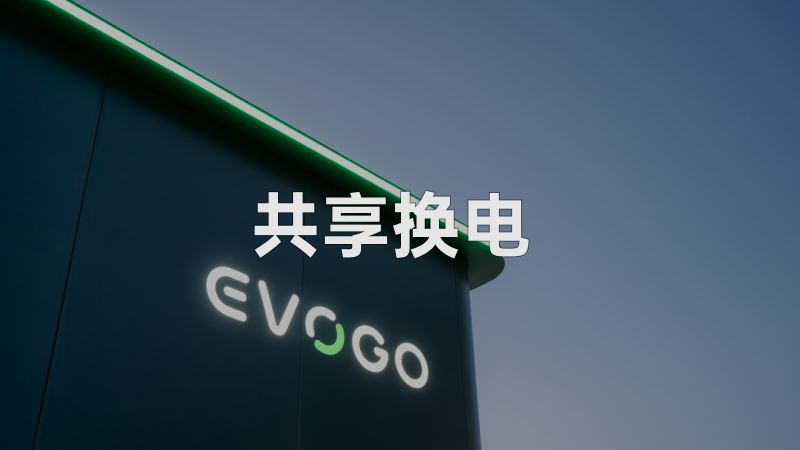On April 18th, 2022, after 90 days since the announcement of NIO’s EVOGO battery swapping system, the first batch of 4 EVOGO battery swap stations officially began operations in Xiamen, breaking the norm of lengthy delivery time in the new energy vehicle industry.
More importantly, with these swap stations in operation, NIO’s battery swapping service has officially entered the practical operational stage, moving beyond mere PowerPoint presentations.
“Green Circle” in Xiamen
Mass Production of EVOGO
Before we delve into NIO’s deployment in Xiamen, let’s first take a look at what the actual mass-produced battery swap station looks like.
A few months ago, before the official release of NIO’s EVOGO, there was a picture circulating online of a battery swap station claiming to be from NIO. The station was poorly constructed, resembling a temporary garage built beside shipping containers, which sparked ridicule towards NIO’s battery swapping system.
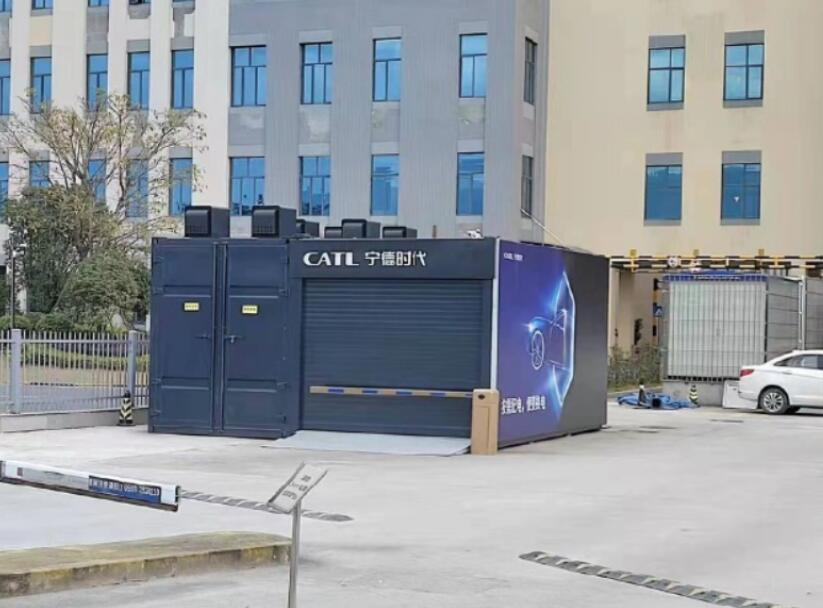
However, NIO officials quickly debunked this picture, clarifying that it was not NIO’s battery swapping station. During their official release, the EVOGO swap station was revealed, with a sleek, distinctive, and recognizable design featuring a silver-grey rectangular building structure. It includes a range of battery swapping ports and a storage chamber for charging and storing batteries.
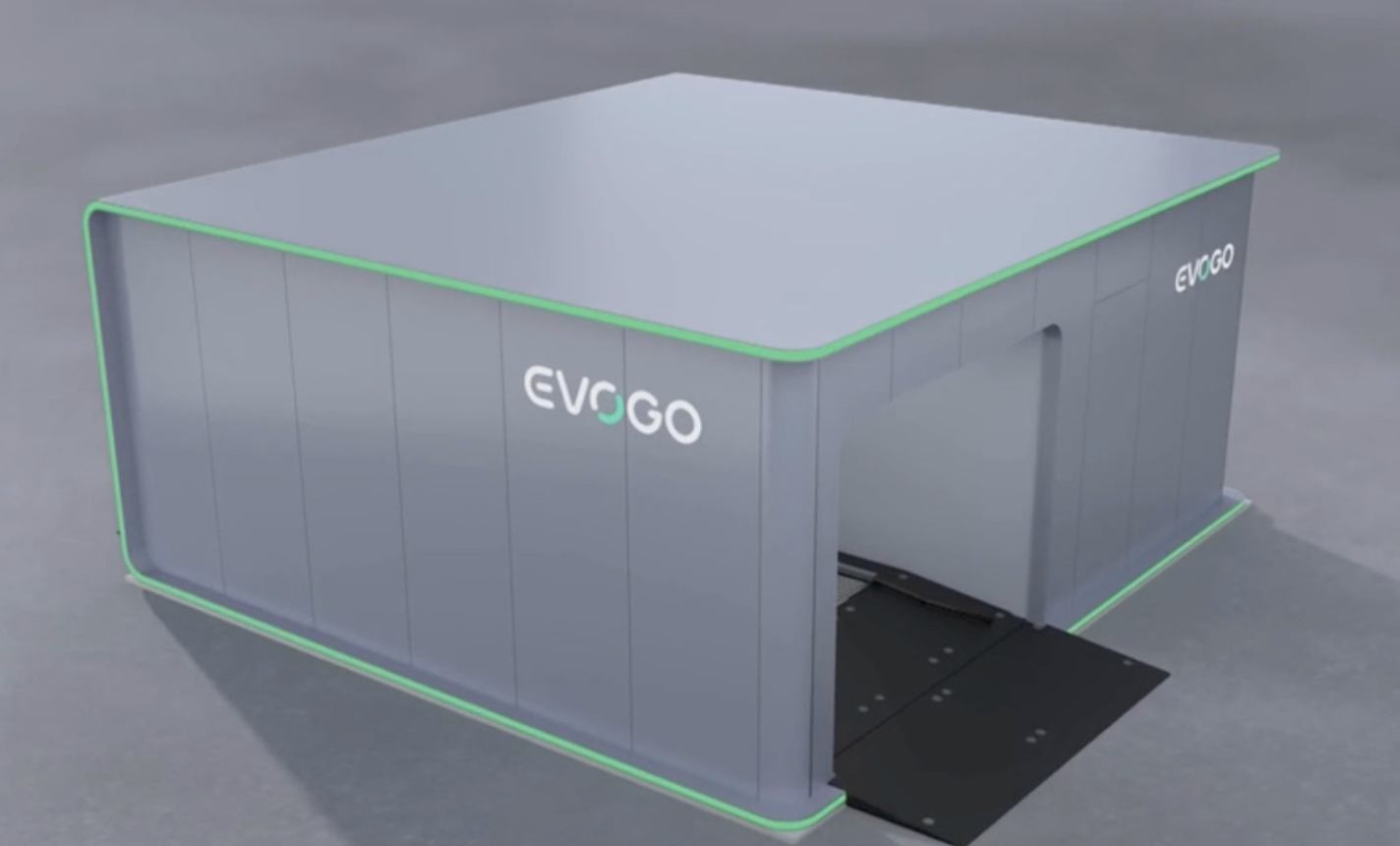
Nevertheless, there’s a saying in the automotive industry: “Concepts are like Lin Zhiling, production models are like Luoyufeng”. So, what’s the reality of the mass-produced EVOGO?
Conclusion: “NIO truly delivers as promised.” The first batch of EVOGO battery swapping stations deployed in Xiamen match the official renders, especially with the main building’s coloring, paint, and rounded corner treatment mirroring what was presented in the renders.
Compared to the rendering, there’s one additional feature in the battery swapping port – an automatic gate-lifting device. When an EVOGO vehicle approaches the battery swap station, the camera of the gate-lifter can recognize the vehicle’s number plate with automatic lifting, allowing the vehicle to drive into the battery swap channel to complete the battery swap process.
It’s worth noting that the automatic gate-lifting device is present because EVOGO was designed to operate without on-site staff. The entire battery swapping process was highly automated, and users needed to follow a few simple steps in the app to complete the process. However, since users are new to the system, staff are still present to guide them.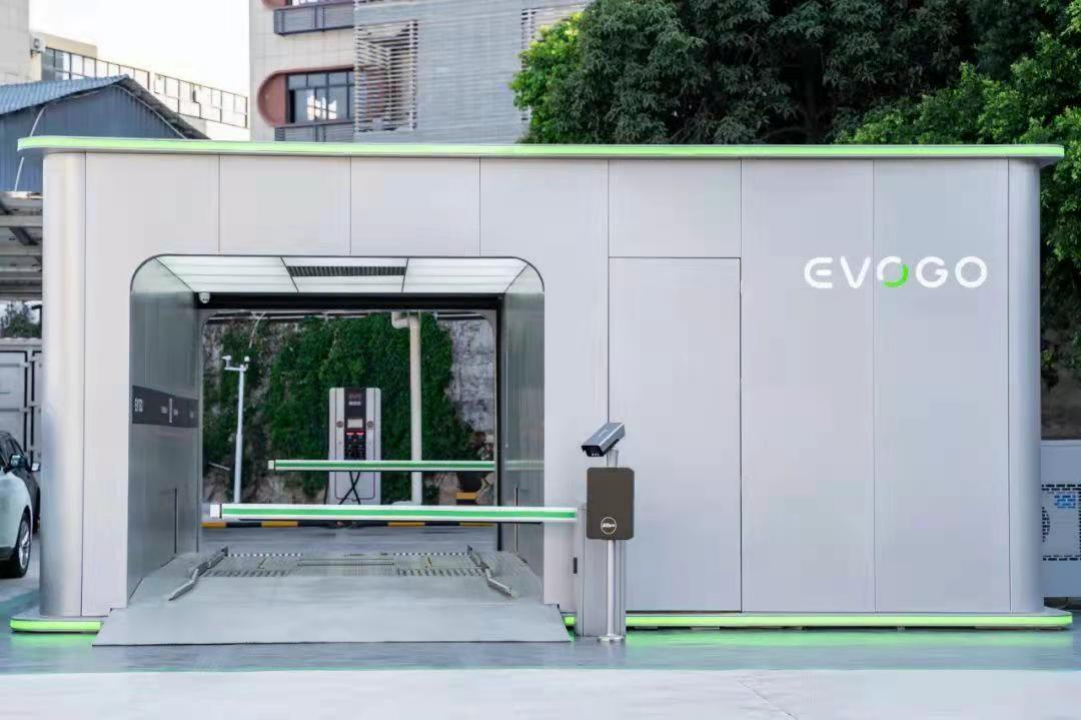
Another obvious but often overlooked feature is that the EVOGO battery swap channel is designed for one-way passage, with one entrance and one exit. This layout is more efficient for incoming and outgoing traffic in high-volume battery swap scenarios compared with a garage-style layout with only one opening. This design of entrance and exit demonstrates the importance that Ningde EVOGO places on the efficiency of the battery swapping process. Combined with the design of 48 batteries per station, it is easy to see that Ningde is considering operational efficiency of big throughputs for single station.
As fellow players in the battery swap market, Ningde EVOGO is similar to NIO in its user-side battery swap operations, with its own user-facing app that displays information about the operating status of target battery swap stations and the number of available batteries. Users can make advance reservations for battery swapping through the app before arriving at the station.
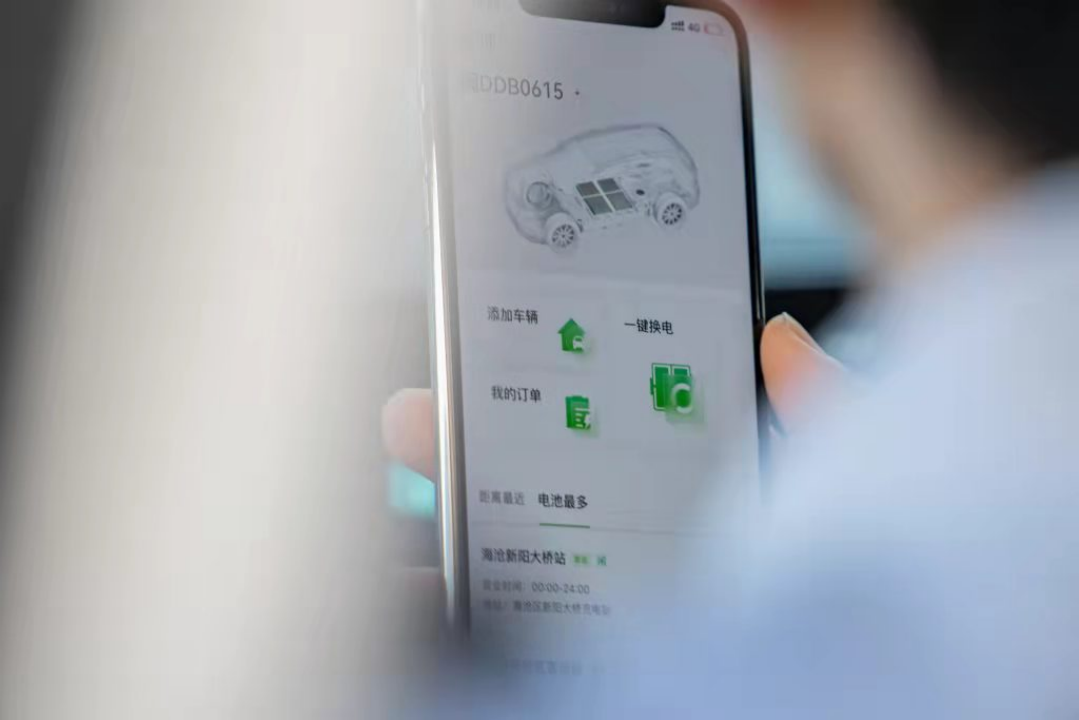
Users make battery swap reservations through the app, and complete the battery swapping process by doing a few steps at the station. After swapping the battery, the user can settle the supplementary energy fee. This is the actual battery swapping process of EVOGO. Now let us take a look at EVOGO’s deployment in Xiamen.
One Station Every 3 Kilometers: A Crucial Pilot Program in Xiamen
On April 18, four EVOGO battery swap stations were officially put into operation in Xiamen’s Siming, Huli, and Haicang districts as shown below.
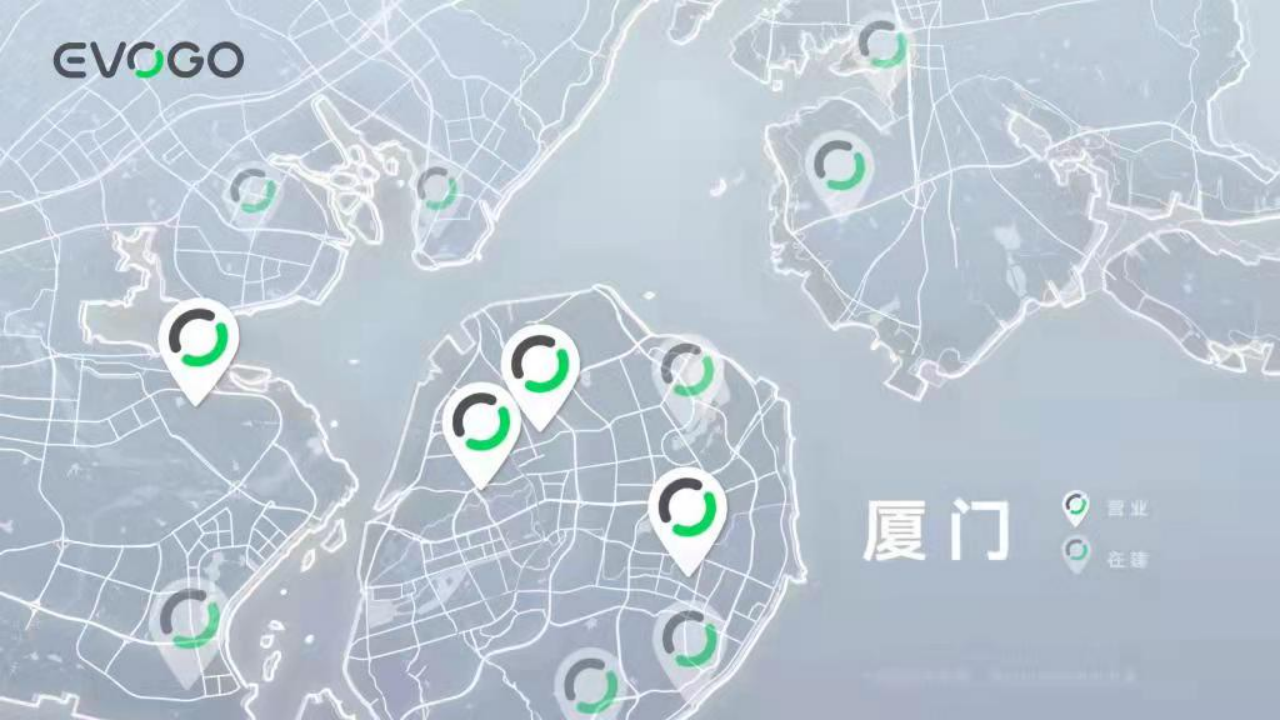
It should be noted that for a city the size of Xiamen, the first four battery swap stations are just a starting point. The semi-transparent icons outside the highlighted area represent the EVOGO battery swap stations currently under construction in Xiamen.
If you find this information insufficiently specific, you can look at the official description: after completion of the construction target, there will be one battery swap station for every three kilometers on Xiamen island.
In other words, by the end of this year, electric vehicles under the EVOGO system in Xiamen can be driven freely for the most part, unless they have only 3 kilometers of remaining range before deciding to swap the battery. Such a density of deployment shows that Ningde Times is trying to turn Xiamen into a demonstration city for EVOGO.
For a giant like Ningde Times, crucial new business ventures are usually launched in safe locations. In August 2021, Ningde Times established a wholly-owned subsidiary, TimesPower Services, for which EVOGO is one of the main businesses. The registered address of TimesPower Services is Xiamen, which is critical for Ningde Times.# Translation
Translate the following Chinese Markdown text to English Markdown text, professionally, retaining the HTML tags inside the Markdown, outputting only the results.
EVOGO is not solely owned by Ningde, and its promotion strategy is similar to other charging and swapping infrastructure. According to the official information released by Ningde earlier, there are currently two types of cooperation projects in the EVOGO system:
-
Swapping station operation cooperation, partners can choose to cooperate with TELD in the field of swapping by way of joint venture or franchise.
-
Vehicle procurement (no less than 100), after purchasing vehicles, TELD will invest and build swapping stations and provide battery leasing services to partners.
At the beginning stage, EVOGO mainly focuses on B-end clients for these two businesses, and the two businesses complement each other. TELD on one side needs to promote electric cars with EVOGO swapping capabilities, and find partners to jointly promote and build swapping stations.
Both the new energy infrastructure and the travel business have limitations and require approvals, so there is some uncertainty in promotions. If local governments can provide certain policy support at the early stage of business development, it will be a great help. TELD chose Xiamen as the first pilot site because of its home-field advantage and adopted a rapid layout strategy for 30 stations by the end of the year.
Trial and error must be done early, TELD hopes to use the home-field advantage to quickly achieve scale swapping operations in specific areas, and accumulate valuable practical experience and real operational data as soon as possible.
Higher station coverage and more optimized operational strategies can enhance the appeal of swapping mode to individual consumers, laying a foundation for EVOGO’s expansion into the personal consumption market in the future. From the perspective of publicity, the pilot of EVOGO in Xiamen will also become an important city advertisement for swapping business.
Apart from the construction of urban swapping stations, TELD has also set its sights on the entire Fujian province and beyond. On February 22nd this year, TELD signed a strategic cooperation memorandum with Fujian Expressway Energy Co., Ltd. The memorandum shows that the two parties will establish a joint venture to jointly build a Fujian-high-speed swapping network, and promote the construction and operation of swapping stations at service areas and stations in Fujian expressways. They will also expand related businesses in surrounding provinces in a timely manner, and accelerate the process of automobile electrification.
Starting from Xiamen and gradually connecting the whole Fujian province through the high-speed swapping network, and then expanding to surrounding areas. This is EVOGO’s gradual swapping network construction strategy. Everything has just begun.
The Pros and Cons of Ningde and Swapping
In recent years, with the development of new energy industry and increasing penetration rate of new energy, the topic of swapping has become increasingly popular. NIO, as a benchmark enterprise in this field, has demonstrated the feasibility of swapping business during this period, and the model of separating vehicle and battery assets has opened up another imaginative way. Today, the emergence of Ningde makes this race track even more lively.
Therefore, at this node in time, we may review some basic knowledge about swapping.
What Problems Could Swapping Solve?The initial appearance of battery swap mode was to solve one of the biggest pain points of electric vehicles — slow charging.
The objective here is not to compare with others, but with the gasoline vehicles that human beings have been using for over a century. Find a gas station, add some fuel and you can refuel your car in just a few minutes, which is a common experience for everyone. Although it is said that a new luxury gradually becomes a necessity, the driving quality and power experience brought by motors are the reasons for many people to switch from oil to electricity. But even today, more people are not willing to sacrifice the convenience of refueling for this reason.
In 2021, the sales of new energy vehicles in the domestic market exceeded 3.5 million units, with only 17% of them equipped with accompanying charging piles. A considerable number of new energy vehicle owners still need to rely on public charging piles to recharge, as they lack home charging facilities.
Although the charging speed in the industry has been improving, charging is still slower than refueling. When we played with the four-wheel-drive cars as children, we could go on a trip with a full battery after changing the battery once. Battery swap is the solution for electric vehicle’s energy supplement with the closest resemblance to refueling, and “fast” is the most important value of battery swap.
When the battery pack can be freely detached and combined with the vehicle body, the electric vehicle becomes a modular product with the potential for DIY and upgrades. One battery can be installed on different cars, and one car can also be equipped with different batteries. The battery is also a component that iterates quickly and deteriorates. This is the second largest value of battery swap: to make the renewal and upgrade of the electric vehicle’s battery easy and without damage.
Furthermore, under the enhancement of separating the vehicle and the electricity, battery swap has created a new “sharing” model for the industry, sharing batteries, reducing consumers’ car purchase threshold, and also reducing the pressure on the automakers in terms of battery costs.
If we look beyond the consumer’s perspective and stand in the enterprise or even the industry’s perspective, battery swap successfully separates the two links of “providing energy for the vehicle” and “providing energy for the battery,” resulting in less instantaneous power impact on the power grid. Due to the energy storage characteristics of the battery itself, the battery swap station with multiple batteries may also become a temporary energy storage station to achieve peak load shaving and valley filling, which benefits the power grid.
This is how the battery swap works. For Ningde Times, which does not produce complete vehicles, its EVOGO business for time-sharing rental of batteries has its own unique features.
Talking about Battery Swap again
After the introduction above, readers with a questioning spirit combined with the current situation of the energy supplement route in the new energy industry would generally ask a question: If battery swap is so good with so many advantages, why are there so few companies that really adopt the battery swap mode?
There can be many explanations for this question, but the most fundamental reason is only one: it is too expensive. The chassis space of electric vehicles is precious, and the volume of the battery and the vehicle’s interior space are in a constant conflict. The complexity of installing a set of battery swap mechanism on it is self-evident. Such a set of mechanism may also need to consider the compatibility with different types or even generations of vehicles, requiring sufficient foresight.The national authorities have also introduced strict durability requirements for this type of vehicle-level activity. Taking the snap-on design adopted by Ningde EVOGO as an example, durability must meet the requirement of at least 8,000 battery replacements, and at least 5,000 battery replacements should not cause damage or wear to the vehicle-side mechanism.
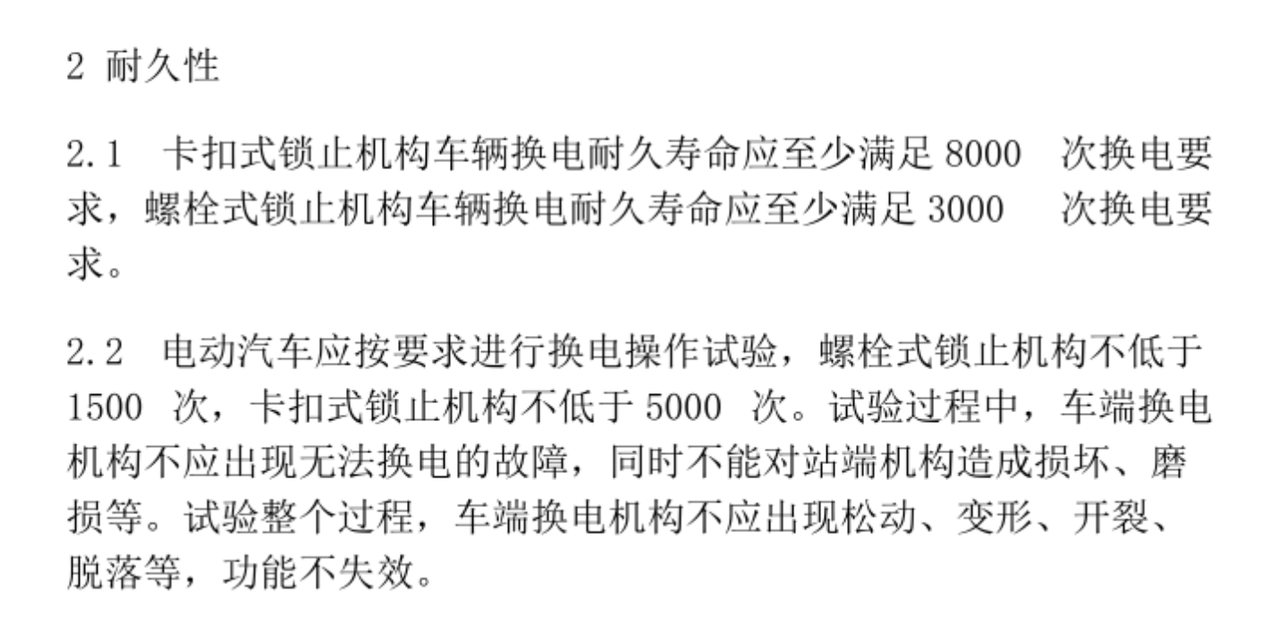
After finishing the vehicles, a complete set of plans needs to be made on the other end of the battery swapping station. Consequently, the engineering workload has become considerable. The cost of the battery swapping routes is enormous for pure electric vehicle models that are not priced very high.
However, another key reason that has caused automakers to be discouraged is that even if they invest so much in engineering costs, they still need a huge amount of infrastructure investment in the battery-swapping system. Unlike the charging routes, which have a large amount of public charging pile resources, if the original equipment manufacturers want to do battery swapping, they still have to build their own battery swapping stations.
While battery swapping is just as fast as refueling, the idea of having to build “gas stations” one by one has caused the automakers to retreat.
I know that at this point, some people may want to use the example of NIO building their own battery swapping station to refute the issue. As a business that is at the forefront of the battery-swapping field, NIO, with its survivor halo, is admirable. However, it is not an object that the industry should refer to.
But as the saying goes, don’t take on work you cannot handle. Please remember that NIO has unprecedentedly built an autonomous luxury brand with an average price of over RMB 400,000, and it is also listed on both the US stock market and the Hong Kong stock market. Its product price and capital structure can support such a heavy investment strategy.
There must be more vehicle manufacturers that can perform battery swapping in the engineering field beyond NIO, but how many of them can sell cars priced over RMB 400,000?
Because of the different chassis, there is “species isolation” among the battery swapping systems of different branded vehicle models, and the battery swapping stations are not compatible with each other. The industry has not yet formed a mandatory unified standard for this.
Under the accumulation of various factors, battery swapping has never formed an industry-level scale, and this is precisely the significance of Ningde Times’ entry into this field as a supplier.
As for the original equipment manufacturers, the most troublesome issue regarding battery swapping is infrastructure investment, and Ningde takes the lead in solving this issue. Under the EVOGO battery swapping system, Ningde is the engineering development party, battery swapping station construction operator, and battery asset company. The battery swapping stations, from the original “gas stations” that had to be built by the original equipment manufacturers themselves, have now become a public resource in the EVOGO system.
Moreover, the modular design plays a very important role in Ningde Times’ EVOGO system, which adapts to different sizes and models by combining the battery swapping blocks with 1 to 3 combinations. In the face of different battery capacity needs, this has now become a simple addition and subtraction problem.
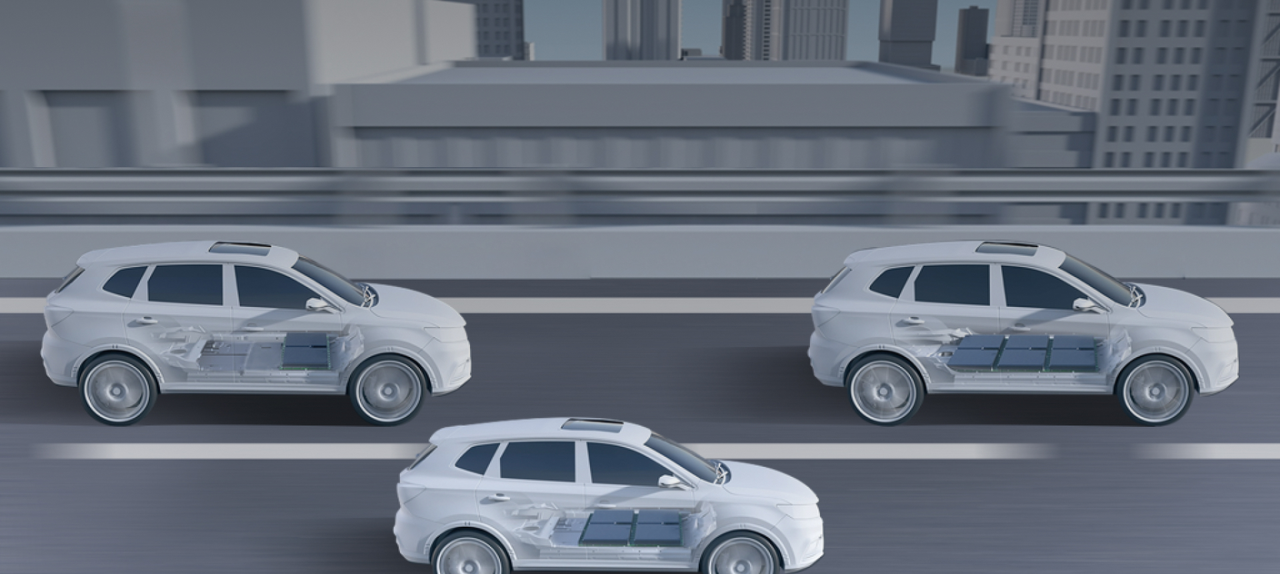 For adaptation, the host manufacturer only needs to make good adaptation of the original electric vehicle and Ningde’s battery bracket to join the EVOGO system, which greatly reduces the cost of replacing batteries for the original vehicle models.
For adaptation, the host manufacturer only needs to make good adaptation of the original electric vehicle and Ningde’s battery bracket to join the EVOGO system, which greatly reduces the cost of replacing batteries for the original vehicle models.
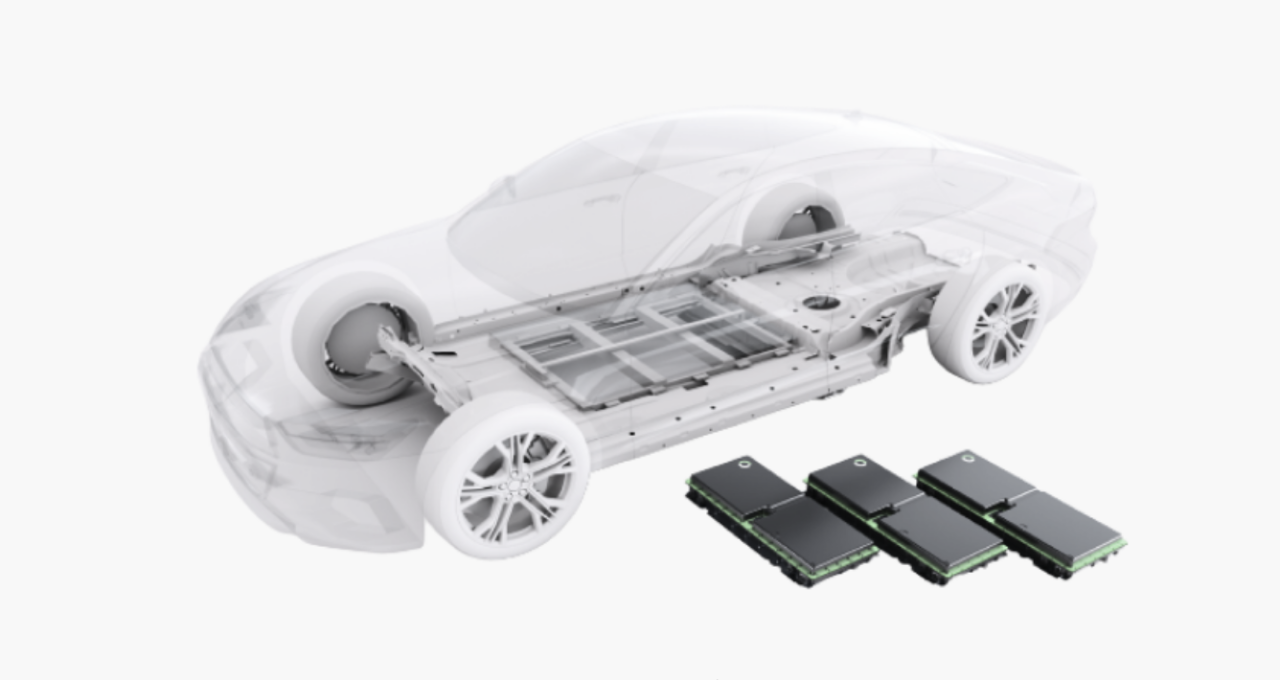
In addition, Ningde is responsible for battery assets in the future, and the host manufacturer only sells “shells” of cars. All the costs related to batteries are transferred to Ningde, and the impact caused by fluctuations in battery costs no longer directly affects the host manufacturer. The ultimate profit of the host manufacturer joining EVOGO is to derive more low-priced battery-swapping models in a more labor-saving and cost-saving way, enrich the product line of vehicle models, and promote overall sales.
For Ningde, the income from EVOGO is battery rental, and the more vehicles that join the system, the higher this part of the income will be. In addition, Ningde itself is a battery giant that integrates upstream and downstream, and a large number of standardized battery cells under the swapping system also provide assistance for subsequent energy storage, hierarchical utilization, and battery recycling businesses, further improving Ningde’s energy ecology.
For consumers, the car-battery separation model has a lower initial purchase cost. For example, the FAW-Benteng NAT swapping electric vehicle model launched in Xiamen area this time is about 80 thousand yuan cheaper than the original model under the battery rental mode, almost half of the price. In terms of second-hand car value preservation, the car-battery separation model removes the depreciation of the battery part, and the lower car price also reduces the base number of the secondary depreciation. In terms of power supplement, having the support of battery swapping also improves the power supplement experience.
This result seems to be a win-win situation for all three parties, but after careful consideration, there are still many idealized aspects. For Ningde, there are still objective risks and uncertainties in the EVOGO swapping.
In the EVOGO system, Ningde provides an overall solution for swapping services, but the people who ultimately pay for this system are not only buying the EVOGO swapping services, but also the cars under this swapping system.
To attract more users, Ningde not only needs to demonstrate its abilities in terms of coverage and efficiency of swapping stations, but also needs to cooperate with more leading companies, introducing more popular vehicle models to join in. This will be a gradual process.
Conclusion
It is undoubtedly a huge challenge to eat from many tables as a third-party swapping service. On this business line, Ningde era needs to make 100% effort to provide the best swapping system possible. However, “Ningde leads the way, and sales depend on the individuals”. Enterprises that join EVOGO must also come up with excellent products to enable more consumers to pay for them, and then achieve scale. In this process, the real competitors with Ningde era are those excellent new energy vehicle models that are enough to make people abandon embracing swapping.To be frank, Ningde EVOGO has embarked on a path that will either lead to success or ruin. However, great companies often accomplish valuable but extremely difficult tasks – they are pioneers, driven by the desire for success that greatly surpasses the fear of failure.
Isn’t this also the case for Ningde’s venture into third-party battery swapping?
Lastly, we welcome everyone to download the Garage App for the latest information on new energy, and if you seek more immediate communication, you can join our community by clicking here.
This article is a translation by ChatGPT of a Chinese report from 42HOW. If you have any questions about it, please email bd@42how.com.
